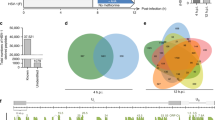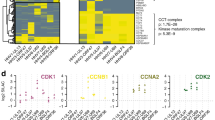Abstract
The discovery of antiviral compounds against human papillomaviruses (HPV) has been hindered by the difficulties in culturing virus in vitro or assaying stable HPV DNA replication. However, plasmids containing the HPV replication origin replicate transiently upon co-transfection with HPV E1 and E2 expression vectors. We have adapted this assay using secreted alkaline phosphatase (SAP) as a reporter for rapid analysis of DNA copy number. Use of the S V40 early promoter in controlling SAP expression was critical in ensuring both a strong signal and copy number dependence: the stronger β-actin promoter inhibited replication, while the weaker SV40 late promoter yielded very low levels of SAP. The precise configuration of the E1 and E2 expression vectors also was critical, most pre-existing vectors did not support efficient replication and SAP secretion. The extent of DNA replication and SAP secretion were both proportional to the amount of E1/E2 vector used in transfections; under optimal conditions SAP increased 100-fold during replication. The assay has been developed for compound screening in 96-well plates and several inhibitors have been identified. Quantitative Southern blot analysis has shown that most of these inhibit HPV DNA replication rather than SAP accumulation or activity, and several are under test hi models of viral replication. The assay also provides a rapid system for functional analysis of the HPV E1, E2 genes and the replication origin.
This is a preview of subscription content, access via your institution
Access options
Subscribe to this journal
Receive 12 print issues and online access
$209.00 per year
only $17.42 per issue
Buy this article
- Purchase on Springer Link
- Instant access to full article PDF
Prices may be subject to local taxes which are calculated during checkout
Similar content being viewed by others
References
Gissmann, L. 1993. Human papilloviruses and genital cancer. Semin. Cancer Biol. 3: 253–261.
Stanley, M.A. 1994. Virus-keratinocyte interactions in the infectious cycle. In: Human Papillomaviruses and Cervical Cancer, Biology and Immunology. Stern, P. L. and Stanley, M. A. (Eds.). Oxford University Press, Oxford.
Ustav, M. and Stenlund, A. 1991. Transient replication of BPV-1 requires two viral polypeptides encoded by the El and E2 open reading frames. EMBO J. 10: 449–458.
Chiang, C.-M., Ustav, M., Stenlund, A., Ho, T.F., Broker, T.R. and Chow, L.T. 1992. Viral El and E2 proteins support replication of homologous and heterologous papillomaviral origins. Proc. Natl. Acad. Sci. USA 89: 5799–5803.
Del Vecchio, A.M., Romanczuk, H., Howley, P.M. and Baker, C.C. 1992. Transient replication of human papillomavirus DNAs. J. Virol. 66: 5949–5958.
Remm, M., Brain, R. and Jenkins, J.R. 1992. The E2 binding sites determine the efficiency of replication for the origin of human papillomavirus type 18. Nucleic Acids Res. 20: 6015–6021.
Yang, L., Li, R., Mohr, I., Claik, R. and Botchan, M.R. 1991. Activation of BPV-1 replication in vitro by the transcription factor E2. Nature 353: 628–632.
Kuo, S.-R., Liu, J.-S., Broker, T.R. and Chow, L.T. 1994. Cell-free replication of the human papillomavirus DNA with homologous viral El and E2 proteins and human cell extracts. J. Biol. Chem. 269: 24058–24065.
Seo, Y.-S., Muller, F., Lusky, M. and Hurwitz, J. 1993. Bovine papillomavirus (BPV)-encoded El protein contains multiple activities required for BPV DNA replication. Proc. Natl. Acad. Sci. USA 90: 702–706.
Yang, L., Mohr, I., Fouts, E., Lim, D.A., Nohaile, M. and Botchan, M. 1993. The El protein of bovine papillomavirus 1 is an ATP-dependent DNA helicase. Proc. Natl. Acad. Sci. USA 90: 5086–5090.
Bream, G.L., Ohmstede, C.-A. and Phelps, W.C. 1993. Characterisation of the HPV-11 El and E2 proteins expressed in insect cells. J. Virol. 67: 2655–2663.
Hughes, F.J. and Romanos, M.A. 1992. El protein of human papillomavirus is a DNA helicase/ATPase. Nucleic Acids Res. 21: 5817–5823.
Seo, Y.S., Muller, F., Lusky, M., Gibbs, E., Kim, H.Y., Phillips, B. and Hurwitz, J. 1993a. Bovine papillomavirus (BPV)-encoded E2 protein enhances binding of El protein to the BPV DNA replication origin. Proc. Natl. Acad. Sci. USA 90: 2865–2869.
Park, P., Copeland, W., Yang, L., Wang, T., Botchan, M.R. and Mohr, I.J. 1994. The cellular DNA polymerase α-primase is required for papillomavirus DNA replication and associates with the viral El helicase. Proc. Natl. Acad. Sci. USA 91: 8700–8704.
Li, R. and Botchan, M.R. 1993. The acidic transcriptional activation domains of VP16 and p53 bind the cellular replication protein A and stimulate in vitro BPV1 DNA replication. Cell 73: 1207–1221.
Haase, S.B., Heinzel, S.S. and Calos, M.P. 1994. Transcription inhibits the replication of autonomously replicating plasmids in human cells. Mol. Cell. Biol. 14: 2516–2524.
Sverdrup, F. and Khan, S.A. 1994. Replication of human papillomavirus (HPV) DNAs supported by the HPV type 18 El and E2 proteins. J. Virol. 68: 505–509.
Nasseri, M., Hirochika, R., Broker, T.R. and Chow, L.T. 1987. A human papillomavirus type 11 transcript encoding an E1-E4 protein. Virology 159: 433–439.
Higgins, G.D., Uzelin, D.M., Phillips, G.E., McEvoy, P., Marin, R. and Burrell, C.J. 1992. Transcription patterns of human papillomavirus type 16 in genital intraepithelial neoplasia: evidence for promoter usage within the E7 open reading frame during epithelial differentiation. J. Gen. Virol. 73: 2047–2057.
Hummel, M., Hudson, J.B. and Laimins, L.A. 1992. Differentiation-induced and constitutive transcription of human papillomavirus type 31b in cell lines containing viral episomes. J. Virol. 66: 6070–6080.
Karlen, S. and Beard, P. 1993. Identification and characterisation of novel promoters in the genome of human papillomavirus type 18. J. Virol. 67: 4296–4306.
Wu, X., Xiao, W. and Brandsma, J.L. 1994. Papilloma formation by cottontail rabbit papillomavirus requires El and E2 regulatory genes in addition to E6 and E7 transforming genes. J. Virol. 68: 6097–6102.
May, K., Planterose, D.N., Browne, M.J. and Perkins, R.M. 1991. Development of a novel marker gene based assay system for detection and evaluation of antiviral agents with activity against papillomaviruses. Antiviral Chem. and Chemother. 2: 363–370.
Sterling, J., Stanley, M., Gatward, G. and Minson, T. 1990. Production of human papillomavirus type 16 virions in a keratinocyte line. J. Virol. 64: 6305–6307.
Jeon, S., Allen-Hoffmann, B.L. and Lambert, P. 1995. Integration of human papillomavirus type 16 into the human genome correlates with a selective growth advantage to cells. J. Virol. 69: 2989–2997.
Meyers, C., Frattini, M.G., Hudson, J.B. and Laimins, L.A. 1992. Biosynthesis of human papillomavirus from a continuous cell line upon epithelial differentiation. Science 257: 971–973.
Berger, J., Hauber, J., Hauber, R., Geiger, R. and Cullen, B.R. 1988. Secreted placental alkaline phosphatase: a powerful new quantitative indicator of gene expression in eukaryotic cells. Gene 66: 1–10.
Millán, J.L. 1986. Molecular cloning and sequence analysis of human placental alkaline phosphatase. J. Biol. Chem. 261: 3112–3115.
Schwarz, E., Durst, M., Demankowski, C., Lattennann, O., Zech, R., Wolfsperger, E., Suhai, S. and zur Hausen, H. 1983. DNA sequence and genome organisation of genital human papillomavirus type 6b. EMBO J. 2: 2341–2348.
Gunning, P., Leavitt, J., Muscat, G., Ng, S.-Y. and Kedes, L. 1987. A human β-actin expression vector system directs high-level accumulation of antisense transcripts. Proc. Natl. Acad. Sci. USA 84: 4831–4835.
Dartmann, K., Schwarz, E., Gissmann, L. and zur Hausen, H. 1986. The nudeotide sequence and genome organisation of human papillomavirus type 11. Virology 151: 124–130.
Cole, S.T. and Danos, O. 1987. Nucleotide sequence and comparative analysis of the human papillomavirus type 18 genome. J. Mol. Biol. 193: 599–608.
Author information
Authors and Affiliations
Rights and permissions
About this article
Cite this article
Plumpton, M., Sharp, N., Liddicoat, L. et al. A High Capacity Assay for Inhibitors of Human Papillomavirus DNA Replication. Nat Biotechnol 13, 1210–1214 (1995). https://doi.org/10.1038/nbt1195-1210
Received:
Accepted:
Issue Date:
DOI: https://doi.org/10.1038/nbt1195-1210



